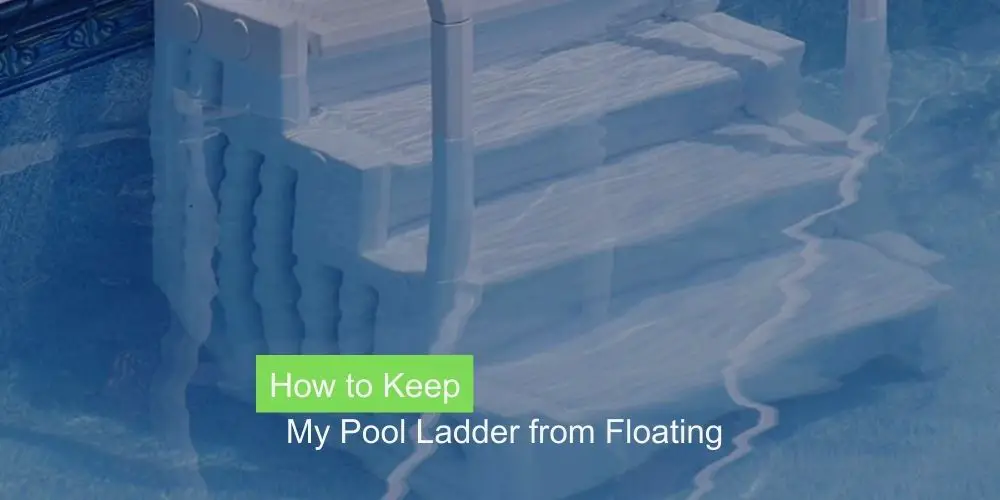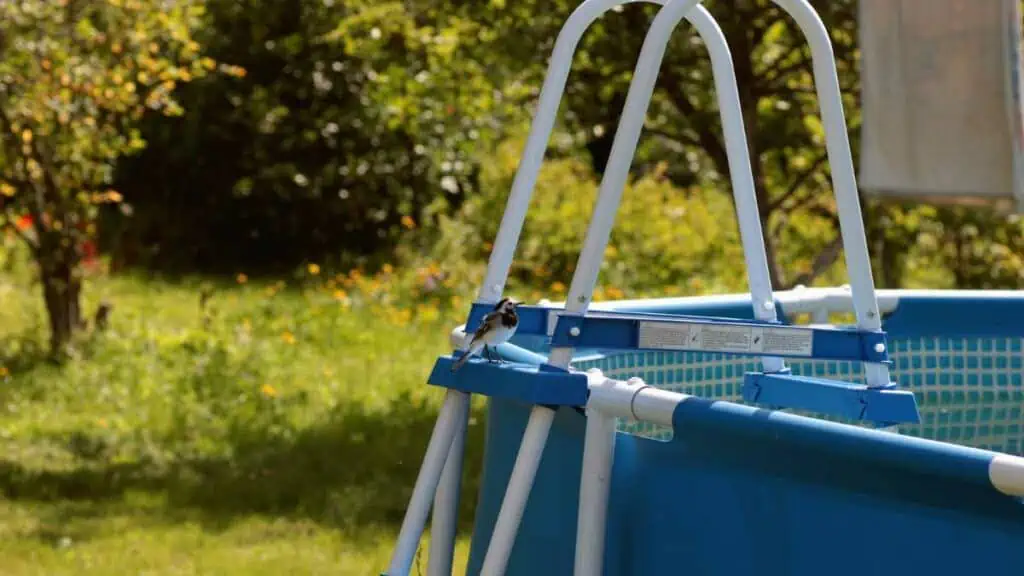
Have you ever gone for a swim in your pool only to be greeted by a rebellious pool ladder that seems to have a mind of its own?
One that, instead of remaining firmly on the pool floor, floats around like a buoy? If yes, then you’ve faced the infamous ‘floating pool ladder’ issue.
This article will delve into the heart of this problem and provide solutions on how to keep your pool ladder from floating.
Why Does a Pool Ladder Float?

1. Inherent Design
Ironically, the same lightweight design that makes pool ladders easy to install and move around can also make them prone to floating. Some pool ladders are designed with hollow steps or bodies, which can trap air and make the ladder float.
2. Improper Installation
Another common culprit? Improper installation. If not properly secured, pool ladders can dislodge and float around.
3. Water Level Discrepancies
And let’s not forget the water level. If the pool’s water level is too high or too low, it could impact the stability of your ladder, causing it to float.
4 Steps to Keep Your Pool Ladder from Floating
A floating pool ladder can be hazardous. It might flip over, causing injury, or at least provide an unstable platform, making getting in and out of the pool risky.
1. Increase the Ladder’s Weight
One of the simplest and most effective solutions to prevent your pool ladder from floating is to add more weight to it.
This approach works on the basic principle of buoyancy, where an object will float if it’s lighter than the amount of water it displaces. By adding weight, we can increase the ladder’s density, making it heavier than the volume of water it displaces, hence keeping it at the bottom of the pool.
Most pool ladders, especially those made of plastic, are hollow, providing ample room to add additional weight. This hollow space can be filled with a heavy substance to increase the ladder’s overall mass.
A common and effective material to use is sand. Sand is not only readily available but also cheap. It’s dense enough to add significant weight and small enough to be packed tightly within the ladder’s hollow spaces. Pour the sand into the ladder until it is filled, making sure to seal it well to prevent sand leakage into the pool.
2. Use a Ladder Anchor
If you’re battling with the persistent issue of a floating pool ladder, one solution that may be just what you need is using a ladder anchor.
A ladder anchor is a device specially designed to secure ladders, and in our case, pool ladders, firmly to the pool floor. These anchors are generally constructed from durable and water-resistant materials, such as stainless steel or hard plastics, ensuring their longevity in the watery environment of your pool.
Using a ladder anchor to prevent your pool ladder from floating is an effective and reliable solution. These ingenious devices can help ensure your pool time is safe, fun, and free from unexpected floating ladders by providing a stable base and secure attachment point for your ladder.
3. Use Ladder Stabilizers
Ladder stabilizers, also known as ladder stabilizer bars, are essential to ensure your pool ladder’s safety and stability.
They increase the safety of your pool ladder by providing a more stable base for swimmers to climb in and out of the pool. They can prevent accidents caused by the ladder tipping over or moving unexpectedly.
4. Pool Ladder Mats
Pool ladder mats serve multiple purposes in maintaining your pool’s functionality and longevity. These mats are placed under the pool ladder where it meets the pool bottom, providing a protective layer between the ladder and your pool liner. They help to prevent the ladder from scratching or puncturing the liner, which can lead to leakage and extensive repair costs.
These mats come in different sizes and materials, so you can choose one that best suits your pool and ladder type. Rubber or heavy-duty vinyl are common materials used, as they are both durable and provide excellent traction. Additionally, most pool ladder mats are designed with a textured surface to increase grip and stability further.
How To Maintain your pool ladder successfully
Regular maintenance of your pool ladder is crucial to prolong its lifespan and ensure it remains safe to use. Here are some steps you can take to keep your pool ladder in the best possible condition.
1. Regular Inspections
Inspect your pool ladder regularly for any visible signs of damage or wear and tear. Look out for signs of corrosion, especially if your ladder is made of metal. Pay attention to the steps, the ladder’s rails, and the points where the ladder meets the pool deck or the pool floor.
2. Tighten Loose Screws
Over time, the screws that hold your ladder together can loosen. This can make the ladder unstable and increase the likelihood of it floating or causing an accident. Regularly check the tightness of all screws and fasteners and tighten any that are loose.
3. Clean the Ladder
Cleaning your pool ladder regularly can prevent algae buildup, which can make the steps slippery and dangerous. You can use a brush, mild detergent, or a special pool cleaning solution. Remember to rinse thoroughly after cleaning.
4. Monitor the Ladder’s Weight
If you’ve added weights or anchors to prevent your ladder from floating, make sure to check these regularly as well. Ensure they are still securely attached and provide enough weight to keep the ladder in place.
5. Repair or Replace Damaged Parts
If your inspections reveal any damage or worn-out parts, repair or replace them promptly. This could involve replacing a worn-out step, fixing a damaged rail, or re-securing the ladder if it’s become detached from the pool floor or deck.
6. Winterize If Necessary
If you live in a region where you close your pool for the winter, don’t forget to winterize your ladder. This usually involves removing it from the pool, cleaning it thoroughly, and storing it in a safe, dry place.
Regular maintenance can help you avoid unnecessary costs, prevent your pool ladder from floating, and, most importantly, keep your pool safe for everyone to enjoy. Remember, the longevity of your pool ladder largely depends on how well you take care of it.
Final Words
Taking control of your floating pool ladder doesn’t need to be a confusing or frustrating process. You have multiple strategies at your disposal, ranging from increasing the weight of the ladder and using ladder anchors or stabilizers to employing pool ladder mats. Professional help is just a call away if these methods aren’t fruitful.
The pool is meant to be a place of relaxation and enjoyment. Don’t let a floating ladder ruin your swim. You are well-equipped to handle this issue effectively with the information shared in this article. Happy swimming!

Hi, This is Josh. I am a former competitive swimmer and current fitness enthusiast.
I created this site to share my love of swimming with the world!

